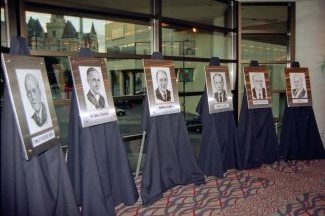2004 INDUCTEE Oswald Avery, MD Cells, Genetics & Genomics, The Early Days - Health Care Pioneers, Infectious Disease, Allergy & Immunity
October 21, 1877
(Halifax, Nova Scotia)
February 20, 1955
MD, Columbia University (1904)
1950: Honorary DSc, University of Chicago
1947: The Lasker Award, American Public Health Association
See All AwardsAwards & Honours:
1950: Honorary DSc, University of Chicago
1947: The Lasker Award, American Public Health Association
1945: Copley Medal, Royal Society of London Member of the National Academy of Sciences, USA
1944: Gold Medal, New York Academy of Medicine
1936: Member of the American Academy of Arts and Sciences
1935: Honorary LLD, McGill University
Member of the National Academy of Sciences, USA
Honorary Degree, New York University
Honorary Degree, Rutgers University

Transformed our understanding of DNA

A founder of immunochemistry and molecular biology
Born in Halifax, Nova Scotia, Oswald Avery entered general medical practice following his graduation from Columbia University’s College of Physicians and Surgeons. Soon, however, Avery became frustrated with medicine’s inability to help his patients - most of whom were suffering from tuberculosis and pneumonia - and moved to medical research. He accepted a position with the Rockefeller Institute for Medical Research, New York where, for the next 35 years, he focused his investigations on pneumococcus, tuberculosis and immunology.
Avery’s greatest contribution came in 1944. In collaboration with his colleagues Colin MacLeod and Maclyn McCarty, Avery revealed that the substance (i.e., the gene) that could transform one type of pneumococcus into another was deoxyribonucleic acid (DNA).
Key Facts
The Avery group’s article on the transformative role of DNA has been cited over 2,000 times
Nominated for the Noble Prize on several occasions
Served as President of the American Association of Immunologists, the American Association of Pathologists and Bacteriologists, and the Society of American Bacteriologists
Authored 91 scientific publications in peer-reviewed journals
Professional timeline
Impact on lives today
The Avery Group’s discovery of the structure of DNA has been called one of the most pivotal discoveries of the 20th century. Standing on the foundations of his revolutionary research, scientists have made ground-breaking advances in molecular biology. Most famously of course was the discovery of DNA by Watson and Crick in 1953, however, Avery’s inspiration and influence have lasted well-into the 21st century. While Avery and his colleagues’ discovery was met with skepticism at the time, today their experiments stand as the definitive proof that DNA is a hereditary material with transformative capacities and, as a result, ushered in the contemporary era of genetic research.

2004
-

Oswald Avery posthumously inducted into the Canadian Medical Hall of Fame
Ottawa, Ontario
-

Watson and Crick discover the structure of DNA
Cells, Genetics & GenomicsWithin a decade of the publication of The Avery group’s 1944 revolutionary paper, Watson and Crick built on the Avery group’s insights when they revealed the structure of DNA to be a base-paired double helix.
-
Avery’s work inspired a flood of new research
Cells, Genetics & GenomicsBetween 1945 and 1947, more than 250 papers were published on nucleic acids and nucleoproteins.
-
The Journal of Experimental Medicine published the breakthrough discovery of Avery, MacLeod and McCarty
Cells, Genetics & GenomicsThey demonstrated that the transformation of pneumococcus bacteria from one type to another was the result of interaction with DNA. This changed the understanding that genes are made of DNA and not proteins.
-
Avery and Macleod began to study the transformation of pneumococcal bacteria
Infectious Disease, Allergy & ImmunityThey wanted to understand how pneumococcal bacteria changed from a non-virulent to a virulent form.
-

After a number of years in medical practice, Dr. Oswald Avery pursued medical research
Cells, Genetics & GenomicsHe was offered a position at the Rockefeller Hospital where he was involved in the development of the first effective immune serum against a strain of pneumococcus. He also began to classify the different types of pneumococci.
-

At the age of 10, Avery and his family moved from Halifax to New York City
While his father, a Baptist Minister, became a pastor at the New York City church, Avery continued his education, eventually arriving at Columbia University to study medicine.
1887
His work provided the historical platform of modern DNA research.


